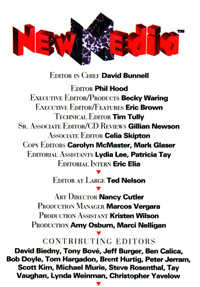|
Vaughan Family Timestream® Maps |
| Home Biography People Places Multimedia: Making It Work On the Water Writings/Presentations |
Ask the Captain
June, 1993
From "Ask the Captain," a monthly column by Tay Vaughan.
New Media Magazine.
Q. I do a lot of cutting and pasting in Photoshop on the Macintosh to make menus and action screens. Is there an easy way to paste one bitmap (such as a company logo) onto another background bitmap (such as a scenic landscape) and make it look smooth and antialiased?
-- Peter Woermann, Newburyport, MA
A. This trick requires several steps. First, select the image you want to paste and copy it to the clipboard. Then open the background image upon which you want to place the image and paste the contents of the clipboard. Select Border (in the Select menu) to create a border of about 2 pixels around the still-selected bitmap. Then blur this 2-pixel border (Blur in the Filter Menu). One further trick: if your bitmap has open parts through which you want to expose the background, make all these parts white. When you paste, use the Paste Controls (under the Edit Menu), and adjust the "Floating Selection" value down one notch from 255 to 254 - this eliminates all white pixels from the image you are pasting. In Photoshop, Command-H will make the dotted lines surrounding your selection invisible so you can actually see what you have done before you commit to the action.
---
Q. The guys in my office are always talking about the latest version of this or that software, and sometimes I feel like I'm pretty far behind. Is it always important to have the latest and the greatest?
-- Bill Thompson, New Orleans, LA
A. Well, that kind of conversation is like the boys discussing hot cams and hemi heads over a lukewarm six-pack on a Saturday afternoon. Mostly lots of talk and arcane words. It's not what you know about versions and features, it's how you make your software stand up and dance for you. Spend your time on the learning curve getting real good at what you do - the same guy that talks about version superX of your word processor may not even know how to set the margins for his printer.
As for staying latest and greatest, it is definitely NOT always important. Vaughan's Law of Multimedia Minimums applies here:
There is an acceptable minimum level of adequacy that will satisfy the audience, even when that level may not be the best that technology, money, or time and effort can buy.
If your software does the job for you and is adequate, don't worry about upgrading. My well-oiled 1932 cast iron Singer can sew the luff of a storm sail just as well as my neighbor's modern fancy-bobbin, zig-zagging electronic job that's always blowing fuses. If the features offered by an upgrade can save you time and money, however, then balance the cost against your savings, and decide.
---
Q. I have a 16-bit sound card in my computer, a CD-ROM player, and software that will let me work with 44.1 KHz stereo audio. But I can't figure out how to import the digital information from the tracks of an audio CD. Is there something I don't know?
--Steven Rubenstein, Scarsdale, NY
A. Yes. The music industry does not want you to mess around with their tunes, at least not too easily. While the audio tracks of a CD are, indeed, digital and could be easily managed by your computer and your editing software, normal CD-ROM players are designed and built without the circuitry to pass that information through the SCSI port. Even though an audio track on a CD appears as a legitimate computer file, you can't copy or read the information. This may change during the next few years.
---
Q. In Macromedia's Director, sometimes I get annoying changes of color when animations play from one frame to another. What causes this and how can I avoid it?
--Randy Fullerton, Milwaukee, WI
A. You must be working in 8-bit color. Each 8-bit image carries with it an associated palette of any combination of only 256 colors (black and white are always required); when you change frames in Director, palette information is updated before the new image is painted onto the screen, so the old picture will flash briefly with the new picture's combination of colors.
One way to avoid palette flashing is to map all the images of your project to a single shared and optimized 256-color palette, but you will sacrifice the 256 best colors for each image and end up with an average compromise among all. Apple's System Palette provides a good combination of the most commonly oiccurring colors, and Director allows you to quickly remap your images to this palette.
Another way to avoid palette flashing is to briefly fade to black or white (both are present in all 8-bit color palettes) before showing frames that use different palettes.
Send your questions to TAY c/o NewMedia, 901 Mariner's Island Blvd., Suite 365, San Mateo, Calif. 94404 or send a fax to (415) 573-5131. Writers of published questions will receive a NewMedia T-shirt and prompt answers to their questions. Tay is president of Timestream, Inc,. a CD-ROM and multimedia title production and publishing company, and is author of Multimedia: Making It Work, (Osborne/McGraw-Hill).

